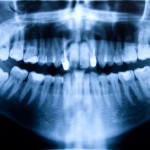
Dry socket (alveolar osteitis) is a troublesome complication to tooth extraction and is reported to occur in around 0.5- 5% of routine extractions with a higher incidence being reported in mandibular molars, particularly impacted wisdom teeth.
The aim of this study was to compare the effect of application of 0.2% chlorhexidine gel, a eugenol-based paste on the postoperative incidence of alveolar osteitis in patients having third molars extracted.
Methods
Patients having third molar extractions were randomised to having 0.2% chlorhexidine gel, Alvogel or nothing placed in the extraction socket prior to suturing. Patients were prescribed metronidazole 400 mg three times daily for 3 day and aceclophenac + serratiopeptidase twice daily for 3 days, and were reviewed on postoperative days 1, 3, and 7.
Results
- 270 patients (160 male and 110 female) were randomised 90 per group.
- 11 of the 270 patients (4%) developed alveolar osteitis on postoperative day 7; 9 patients in the control group (10%) and 2 (2%) of the chlorhexidine group.
- Mean VAS main scores were highest for the control group on day 1, 3 and 7.
- Wound healing was poorest in the control group on day 7 with a mean score of 2.51 compared to 1.69 and 1.32 in the chlorhexidine and eugenol groups.
Conclusions
The authors concluded:
Eugenol proved to be the most effective of the two interventions not only in relation to the incidence of alveolar osteitis but also the presence of pain, infection, inflammation, and wound healing. We suggest the routine use of eugenol paste (Alvogyl) after extraction of a third molar not only as a preventative measure against alveolar osteitis but also to reduce pain, inflammation, and promote wound healing.
Comments
The 2012 Cochrane review by Daly et al (Dental Elf – 13th Dec 2012) looked at local interventions for the management of alveolar osteitis and found some evidence to support the use of chlorhexidine gel but insufficient evidence for any of the other interventions including the use of Alvogel, so it is interesting to see them compared in this study.
While the authors report that they undertook a sample size calculation they do not state on which outcome measure it was based. There is also limited information on the number of surgeons participating and also which teeth are extracted for. Although third molars are mentioned in the title and the abstract, they are not mentioned in the methodology.
There is also a lack of detail on the randomisation process and no indication of who assessed the outcome although it is suggested that this is a double blind study. The authors note that the incidence of the main outcome was low (4%). This could have been due to the use of antibiotics, exclusion of smokers people who misused alcohol, and women on oral contraceptives, which have been identified as possible risk factors and point highlighted by the authors.
However, extraction trauma has been highlighted as an important risk (Dental Elf – 14th Feb 2012) and complex or duration of the extraction procedure has not been discussed. The Cochrane review only included 2 trials, which looked at the use of Alvogel so high quality studies are needed to clarify the size of the effect.
Links
Jesudasan JS, Wahab PU, Sekhar MR. Effectiveness of 0.2% chlorhexidine gel and a eugenol-based paste on postoperative alveolar osteitis in patients having third molars extracted: a randomised controlled clinical trial. Br J Oral Maxillofac Surg. 2015 Jul 15. pii: S0266-4356(15)00231-4. doi: 10.1016/j.bjoms.2015.06.022. [Epub ahead of print] PubMed PMID: 26188932.
Dental Elf – 14th Feb 2012 – Traumatic extraction carries a high risk of a painful dry socket
Dental Elf – 16th July 2015 – Dry socket – oral contraceptives may increase incidence

Genial!
Dry socket prevention: eugenol or chlorhexidine? http://t.co/Y5N5zd1YHo
Ahmed El Dakrouri
Alvogel after xla to prevent dry socket
Eugenol dressing better than chlorhexidine for dry socket prevention? http://t.co/Y5N5zcKnPQ
Don’t miss – Dry socket prevention: eugenol or chlorhexidine? http://t.co/Y5N5zcKnPQ